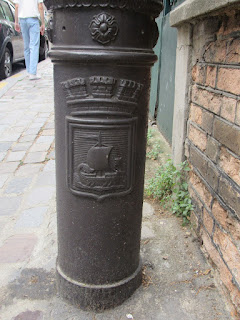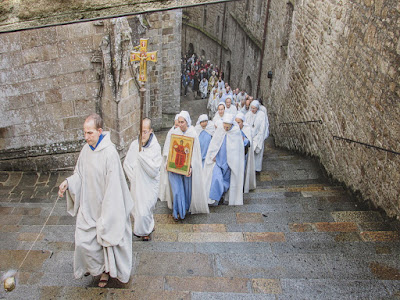
Almost everything you see and feel in Montmartre today you would have seen and felt in the latter 19th century. This was the Belle Epoque (1871-80), a time of optimism; regional peace; economic prosperity; colonial expansion; and technical, scientific, and cultural innovation--a stark contrast to the horrors of the Napoleonic Wars (1803-15) and before the devastation of World War I (1914-18). During this in-between time, Paris flourished in every way.
Montmartre, in particular, became a cultural jewel as it attracted Bohemian artists to its engaging ambience and cheap rents. Impressionist painters like Van Gogh, Monet, Renoir, Toulouse Lautrec lived here, and they hung out on the Place du Tertre, an open-air gallery that still hosts artists today. Montmartre exudes the same "joie de vivre" with its sidewalk cafés, cobble-stoned lanes, tree-shaded terraces.
Montmartre had always been a separate village since ancient times located on a butte overlooking Paris until it was incorporated into the city in 1860. Today, it remains a unique part of Paris that retains its 19th century character without much modernization. Sacré Cœur
One of Montmartre's spectacular landmarks is the Sacré Cœur, which was built 1875-1914. The disastrous Franco-Prussian War prompted the Bishop of Nantes, Felix Fournier, to claim that the defeat was due to France's "moral decline" since the Revolution. He proposed that a church be built on the butte overlooking the city and dedicated to the Sacred Heart of Christ.
Even though it is considered one of today's architectural treasures, the Neo-Byzantine-Romanesque basilica's entire history has been shrouded in controversy. Some people didn't like its purpose of atoning for the country's "sins". Some people didn't like the design. Others didn't like that it was in the place where the Paris Commune originated. (The Paris Commune was a left-wing Marxist-oriented group of workers who overthrew the government for its failures to protect the city during the Prussian siege. Although the workers ruled from March 18 to May 28, 1871, the French army retook the city and slaughtered tens of thousands in the process.) Leftist journalists and politicians still criticize the government for these acts today, and a bomb went off in the basilica in 1976.
The extraordinary white surface of Sacré Cœur is travertine limestone, which is mined nearby Paris. What makes it white is the secretion of a substance in the stone that hardens in the sun. And when it rains, the building literally washes itself.
Two famous figures highlighted on the front porch of Sacré Cœur are Louis IX (left) and Joan of Arc (right). People are familiar with the story of Joan's bravery in leading a defeat against the English in order to crown Louis VII as King of France. Louis IX was a crusader in the 7th and 8th crusades. His admirers through the centuries have regarded him as the ideal
Christian ruler given his skill as a knight, his implementation of a justice system, his ability to arbitrate disputes, and his engaging manner with the
public. He also brought the Crown of Thorns from Jerusalem to France, which was held in Notre Dame Cathedral before the 2019 fire. It is now kept in the Louvre.
The campanile, or bell tower, on the north front, houses the 19-ton Savoyarde bell (one of the world's heaviest), cast in 1895 in Annecy. It alludes to the Savoy region's annexation to France in 1860.
The dramatic view of Sacré Cœur approaching it from the street is an experience that represents movement from the secular to the holy. The basilica seems to pop up out of nowhere. The whiteness of its exterior only adds to its mystical quality of this beautiful and unusual building.

From the dome of the Sacré Cœur, it's possible to see 50 miles to the horizon. This particular day was cloudy and rainy, but the overlook of Paris was nevertheless a thrilling sight to see--and a good reason to return there on a clearer day.
What's in a Name?
The name, "Montmartre" comes from two possible sources. The Romans constructed a temple on the site of this convent and dedicated it to Mars, the god of war. Thus, the name:
Mont (high cliff) + Mars
It is also possible, and more probable that the name refers to St. Denis, who was martyred in Paris and buried here, thus:
Mont (high cliff) + martyre
St. Denis -- Patron Saint of Paris  Saint
Denis
was beheaded in 250 by the Romans for spreading the new religion of
Christianity. He then carried his head
several miles to where his tomb was eventually located in the Basilica
of Saint Denis on the north side of Paris. The Basilica later became the traditional resting place
for the French kings until the Revolution (1789-99). St. Denis was also the
first Gothic cathedral, a new kind of religious architecture that
emphasized the importance of
light as a symbol of divinity. Designed by Abbot Suger, the king's advisor from 1135 to 1144, the basilica was completed in the 13th century.
Saint
Denis
was beheaded in 250 by the Romans for spreading the new religion of
Christianity. He then carried his head
several miles to where his tomb was eventually located in the Basilica
of Saint Denis on the north side of Paris. The Basilica later became the traditional resting place
for the French kings until the Revolution (1789-99). St. Denis was also the
first Gothic cathedral, a new kind of religious architecture that
emphasized the importance of
light as a symbol of divinity. Designed by Abbot Suger, the king's advisor from 1135 to 1144, the basilica was completed in the 13th century.
The Windmills of Montmartre

At one time the
village of Montmartre had 14 windmills t0 grind grain. As the village
grew, they were all taken down except for the Moulin Blute-Fin and
Moulin
Radet, which date back to 1717. Known together as Le Moulin de la
Gallette, the two windmills provided inspiration for a number of
painters including Renoir and Van Gogh. Renoir's masterpiece, Le Bal du Moulin de la Galette, shows a traditional dance in 1876 at the Moulin de la Galette. The painting hangs in the Orsay Museum.
 Today, the historic restaurant (83 Rue Lepic) specializes in
Today, the historic restaurant (83 Rue Lepic) specializes in
seasonal French cuisine.
Bateau-Lavoir ("Washhouse Boat")
Le Bateau Lavoir is the historic workshop of Pablo Picasso who moved here in 1904. The one-time piano factory became the birthplace of Cubism with this painting, Les Demoiselles d'Avignon (1905).

Au Lapin Agile

"Au Lapin Agile" dates to 1860 after it took its name ("Agile Rabbit") from a poster painted by André Gill that depicted a rabbit jumping out of a cooking pot. It was the haunt of avant-garde artists, poets, writers, actors, and singers including Toulouse-Lautrec, Claude Debussy, Vincent van Gogh, Pablo Picasso, Amedeo Modigliani, Max Jacob, and Guillaume Apollinaire. Today, it remains Montmartre's last (and Paris' oldest) cabaret with performers singing traditional French songs and inviting the audience to sing along.
Place du Tertre 
photo by Paris Office of Tourism
Restaurant terraces and bistros share the street with 140 painters, portraitists, and caricaturists who squeeze into 3 square feet of space to paint and sell their works. The word "bistro" was coined at Chez la Mère Catherine Café in 1814. Russian soldiers would shout 'Bystro', (meaning 'quick') to the waitresses so they could hurriedly down a drink
before joining their ranks.
Dalida
And speaking of singing, Dalida (1933-87) was the singer and actress that still is seen today as having had the greatest impact on French society and culture.
She was born in Egypt to Italian parents who eventually moved to France. She became famous in Europe and traveled internationally singing in nine different languages.
Dalida led a tragic diva's life, however. She was engaged to Luigi Tenco, an Italian singer who committed suicide in 1967. Three of her other lovers including her ex-husband also died tragically. Finally, during the night of May 2-3, 1987, Dalida died from an overdose of barbiturates. She left a note: ‘Life has become unbearable for me…Forgive me’. Her funeral was held at La Madeleine and she was buried at the Cimitière de Montmartre. Below is an example of Dalida's dynamic talent with the famous song, "La Bambino."
In this story, a rather inactive, uninteresting man named Dutilleul lived in Montmartre and discovered he could walk through walls. He went to the doctor to seek a cure, but didn't take the prescribed medication he was given. Instead, he used his powers for ill. When he didn't like the new manager at his office, Dutilleul exasperated him with mischief by walking through walls. In fact, the manager went mad and entered an asylum. Dutilleul decided to commit crimes leaving his pseudonym, "The Lone Wolf", scrawled in red chalk at the scene. It gave him infamous public prestige, which delighted him. Then he deliberately let himself be caught and imprisoned. To frustrate his jailers, he walked through the walls and escaped. He fell in love with a married woman whose husband used to lock her in the house while he went out at night. Dutilleul would pass through the house's walls undetected. However, one morning Dutilleul had a headache and accidentally took the pills his doctor had prescribed a year earlier. As the pills took effect, he was trapped in a wall where he remains today.
La Maison Rose (The Pink House)

The house is a famous restaurant in Montmartre and one of the landmarks of the village. Picasso ate here as did Albert Camus, Suzanne Valadon and her son, Maurice Utrillo.

Renault house

As the plaque says, Louis Renault lived here and drove his first gas-powered car on December 24, 1898 to Place du Tertre. He eventually built the first French auto giant.
Ships
Ships are the symbol of Paris, and they are everywhere--on municipal buildings and facilities,
cemeteries and lamp posts.

Vineyard

Cabaret
The cabaret was invented in Montmartre at the end of the 19th century as an encapsulated of the elation and thrill of the Belle Époque through song and dance. Dancers wore costumes of feathers and stepped to a new dance called "the can-can". (Scroll down for more photos and text from this ungodly blank space that I can't eliminate.)
Cabaret is a French word
that means "tavern" where shows of music, dance, much action, and fun take place.
The interior decor is dark and softly lit emitting a mysterious,
intimate ambience. The French cabarets spread to other parts of Europe. In post-war Germany, cabaret became a means of political
mockery, with shows centering on satirical comedy and gallows humor. In America, they became the jazz clubs that were synonymous with speakeasies.

Just down the hill from Montmartre is the Moulin Rouge (Red Windmill). Begun in 1889, the Moulin Rouge today offers musical
dance entertainment for visitors from
around the world. The interior decor still retains much of the
romance of Gay'90s France.
Le Chat Noir (The Black Cat) was another famous cabaret of Montmartre. Although it was only open between 1881-1897, the iconic poster by Théophile Steinlen made it legendary. The cabaret initially projected shadow plays against a white screen. It later became one of Paris' early cabarets with affordable drinks and sensual performances.

to our wonderful guides, Anna and Chantal. You made Montmartre memorable not only with its stories but with your very presence that made Paris even more special.
Resources
My Modern Met -- https://mymodernmet.com/montmartre-paris/
Planetware -- https://www.planetware.com/paris/montmartre-f-p-mont.htm
Civitatis Paris -- https://www.introducingparis.com/cabaret
The Culture Trip -- https://theculturetrip.com/europe/france/paris/articles/paris-s-dazzling-cabaret-a-history/





















































